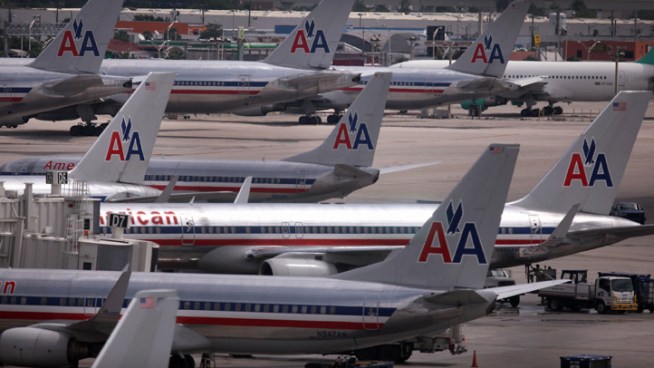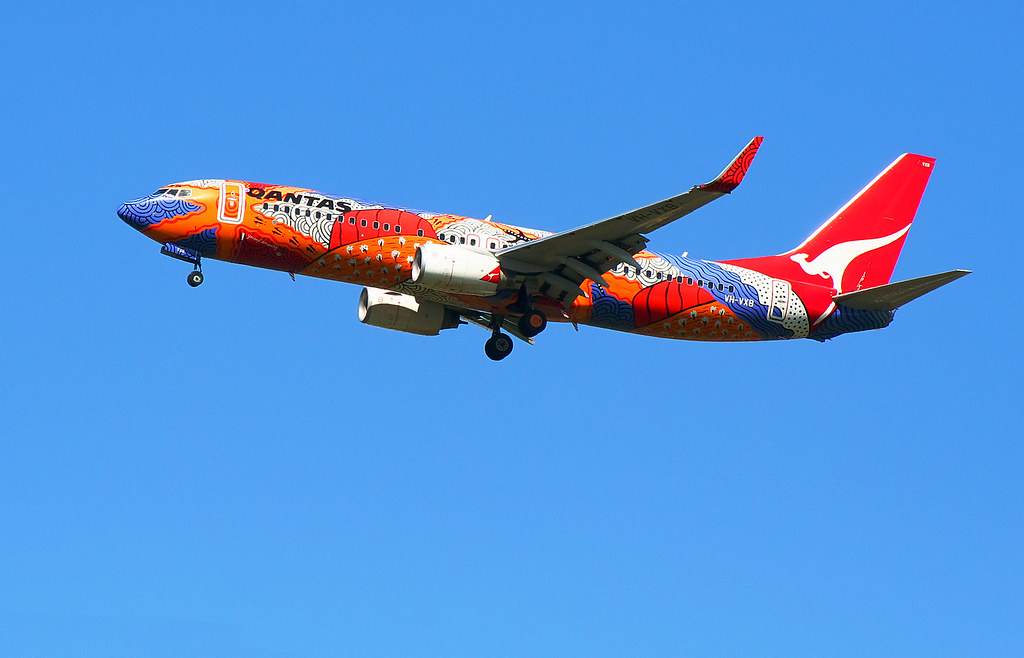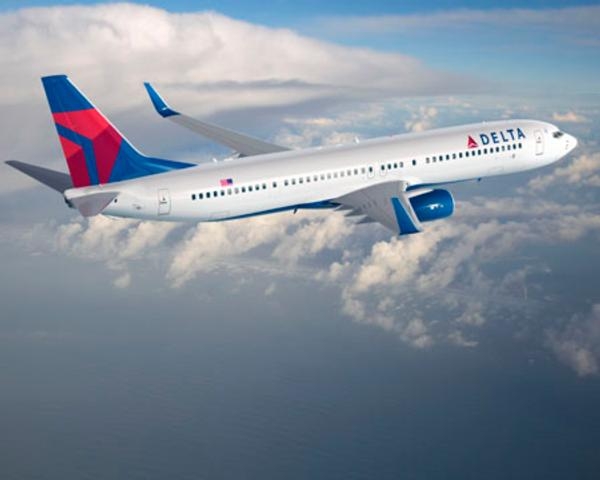I just got back from a trip*, and it's very late and I'm beat, but I wanted to post at least some little tidbit tonight. So here goes.
[*This was actually last week. It was about 3 in the morning when I finally admitted I was too tired to finish this entry.]
I traveled by airplane on this particular trip, and while taxiing to the runway, I watched the other planes we passed and thought again about how I heard once upon a time that painting airplanes adds a whole bunch of weight to the plane, which extra weight results in higher fuel costs. But most airplanes have a bunch of colorful paint on them. If it's true that more paint = more weight = more expensive, why do airlines keep painting their planes?

As you can see from all these airplanes grouped together, nearly all of them are painted in some color scheme or other. White counts as painted. (This photo was originally billed as a multiple exposure of planes taking off from one location, but actually it's just a fairly good Photoshop job of a lot of planes together.)
(Photo by Ho-Yeol Ryu, via Twisted Sifter)

American Airlines planes has used the polished approach for years. Note the shiny metallic appearance on the majority of the body of the planes.
(Photo from NBC DFW.com)

This Qantas special-liveried plane would definitely qualify as "decorative."
(Photo by SE9 on Skyscrapercity)

Washing an airplane isn't just some guy with a bucket and a sponge, it's a pretty complicated operation involving several people, machinery & equipment, and special solvents.
(Photo from British Airways, via Howstuffworks)

Though Delta's planes are painted pretty much all over, the color is mostly on the tail. This gives it a no-nonsense appearance. Which, I must admit, doesn't make me all that excited about getting on board.
(Photo from Aero News Network)
 Conversely, I find Alitalia's livery really appealing. Makes me think that if I rode that flight, I would suddenly be very sleek and fashionable and speaking with an Italian accent.
Conversely, I find Alitalia's livery really appealing. Makes me think that if I rode that flight, I would suddenly be very sleek and fashionable and speaking with an Italian accent.
(Photo posted by Boeing! at Skyscrapercity)

I like this one a lot, too, from Avianca. It looks very aerodynamic and yet also soothing.
(Photo posted by Dreamliner at Skyscrapercity)

This one isn't over the top with the paint and the colors, but it still makes me want to fly to Thailand.
(Photo from Travel Daily Asia)

I have to say, I hope airlines don't take their cue from Southwest. This is downright vomitocious.
(Photo by Nick Ut, from the Atlanta Journal-Constitution)
Sources
Boeing, Painting versus Polishing of Airplane Exterior Surfaces, undated
"Silver Bird" No More? American Planes Likely to Get New Paint Scheme, The Wall Street Journal, July 24, 2012
The Skinny on Airplane Painting, The Cranky Flier, February 24, 2011
New Promise in Paint, Aviation Maintenance, March 29, 2012
[*This was actually last week. It was about 3 in the morning when I finally admitted I was too tired to finish this entry.]
I traveled by airplane on this particular trip, and while taxiing to the runway, I watched the other planes we passed and thought again about how I heard once upon a time that painting airplanes adds a whole bunch of weight to the plane, which extra weight results in higher fuel costs. But most airplanes have a bunch of colorful paint on them. If it's true that more paint = more weight = more expensive, why do airlines keep painting their planes?

As you can see from all these airplanes grouped together, nearly all of them are painted in some color scheme or other. White counts as painted. (This photo was originally billed as a multiple exposure of planes taking off from one location, but actually it's just a fairly good Photoshop job of a lot of planes together.)
(Photo by Ho-Yeol Ryu, via Twisted Sifter)
- Short answer: although it's true that paint adds weight, the increased costs to maintain planes with less paint outweigh or equal the savings in fuel.
- The details behind this are pretty interesting. First of all, there's no such thing as an unpainted plane.
- Every airplane needs to be coated with something so that it can withstand corrosion, resist getting pinged with little rocks and other debris, survive adverse weather, and so on. For this reason, all planes do have a certain amount of "protective" (light gray) paint on key parts of the plane such as all composites, wing fairings, tail cones, etc.
- From the protective coating, the next amount of paint that airlines could choose is considered "polished." This still has the necessary protective paint, plus tiny bits of decorative paint that indicate the airline's name, registry number, logos, and a few small stripes.

American Airlines planes has used the polished approach for years. Note the shiny metallic appearance on the majority of the body of the planes.
(Photo from NBC DFW.com)
- The next level of paintedness is usually referred to as "decorative." Airlines may use anywhere from 3 to 15 colors, and the extra or decorative paint is usually applied on the upper half of the body of the plane (fuselage), on the vertical stabilizer, and on the rudder. The decorative paint might show some kind of design, the airline logo, lettering, stripes, etc.

This Qantas special-liveried plane would definitely qualify as "decorative."
(Photo by SE9 on Skyscrapercity)
- So the amount of weight added by the paint depends on whether the airline has opted for polished or decorative, and how much decorative paint is added. It also depends on the size and type of the plane.
- Below, Boeing has broken down the added weights in a handy table. The numbers across the top refer to types of airplanes.
| 717-200 | MD-80/-90 | MD-11 | 737-700 | 757-200 | 767-300 | 777-200 | 747-400 | |
| Upper and lower half of fuselage and tail painted plus customer markings | 119 (54.0) |
155 (70.3) |
427 (193.7) |
179 (81.2) |
239 (108.4) |
299 (135.6) |
475 (215.5) |
555 (251.7) |
| Upper half of fuselage and tail painted plus customer markings | 94 (42.6) |
120 (54.4) |
312 (141.5) |
130 (59.0) |
157 (71.2) |
202 (91.6) |
330 (149.7) |
368 (166.9) |
| Polished skin and customer markings | 23 (10.4) |
25 (11.3) |
45 (20.4) |
25 (11.3) |
30 (13.6) |
40 (91.6) |
50 (22.7) |
55 (24.9) |
- The paint on polished planes is about 1/10 the weight of the paint on decorative planes. So, clearly, more paint equals more weight.
- As you would expect, that extra weight translates into higher fuel costs because, as Boeing puts it, "Less paint reduces takeoff weight and fuel consumption considerably."
- I tried to find out exactly how much more fuel is burned for every, say, extra gallon of paint. But I struck out here. There are so many variables involved -- type of plane, number of passengers, weight of baggage, distance of flight -- I couldn't find a handy quick calculation. If anybody knows of a quick formula, please tell me what it is in the comments.
- But it turns out that extra fuel costs are not the only concern when it comes to paint. Operating costs are also affected. Basically that means maintenance.
- Planes have to be washed regularly to protect against corrosion. This is true for both painted and polished planes.

Washing an airplane isn't just some guy with a bucket and a sponge, it's a pretty complicated operation involving several people, machinery & equipment, and special solvents.
(Photo from British Airways, via Howstuffworks)
- Also, any paint has to be reapplied every four years to re-coat any areas that may have gotten chipped or thinned. Because extra layers of paint add still more weight, Boeing has made it a policy that no plane can have more than 2 layers of paint. So after it's been repainted once, they have to strip off the old paint and apply new. Sometimes they only scuff-sand the old paint and other times they completely strip the old.
- Polished planes also need some extra attention. Every time they're washed, they also need to be buffed.
- So polished planes require more maintenance. Like painted planes, they get washed frequently. But unlike painted planes, they also have to be buffed with every washing. Then since polished planes do have protective paint on them, they also have to go through the same cycle of repainting, stripping, & repainting.
- Boeing has a little table showing the difference in operating costs are for decorative vs. polished planes, but I confess I'm not sure how to interpret that table. At the very least, I have a lot of questions about it that I can't answer satisfactorily. So I will give you my best guess at the upshot.
- It looks like the operating costs for polished planes exceed those of decorative planes by $60,000 to $82,000 per year.
- As Boeing puts it, "the fuel-cost savings offered by polished surfaces is outweighed by the cost of maintaining the polished surfaces."
- In addition, there's also the question of whether people like or trust polished planes. Some polished planes look a little unfinished, or kind of dinged up, or otherwise manky. If people don't trust an airline to get you there safely, they're not going to buy a ticket. So this is another reason airlines tend to go with more paint. It looks cleaner and safer, and they can also really trumpet their name for all to see.

Though Delta's planes are painted pretty much all over, the color is mostly on the tail. This gives it a no-nonsense appearance. Which, I must admit, doesn't make me all that excited about getting on board.
(Photo from Aero News Network)

(Photo posted by Boeing! at Skyscrapercity)

I like this one a lot, too, from Avianca. It looks very aerodynamic and yet also soothing.
(Photo posted by Dreamliner at Skyscrapercity)

This one isn't over the top with the paint and the colors, but it still makes me want to fly to Thailand.
(Photo from Travel Daily Asia)
- Postscript: American Airlines has been one of the few airlines that has consistently gone with the polished option. But soon this will no longer be the case. Now that they are trying to emerge from bankruptcy, they want to project a new image. So they plan to go with more paint. Also, their newer planes are being constructed with composite and plastic parts which absolutely need to be coated.
- Finally, coatings companies are developing paints that are lighter-weight and more resistant to corrosion, so American (and other airlines) can use these lighter-weight coatings without getting hit as hard with increased fuel costs.
- So we may see airplanes going with even more paint in the future.

I have to say, I hope airlines don't take their cue from Southwest. This is downright vomitocious.
(Photo by Nick Ut, from the Atlanta Journal-Constitution)
Sources
Boeing, Painting versus Polishing of Airplane Exterior Surfaces, undated
"Silver Bird" No More? American Planes Likely to Get New Paint Scheme, The Wall Street Journal, July 24, 2012
The Skinny on Airplane Painting, The Cranky Flier, February 24, 2011
New Promise in Paint, Aviation Maintenance, March 29, 2012
Fuel Burn Rates by Aircraft Type, Aviation Information)














